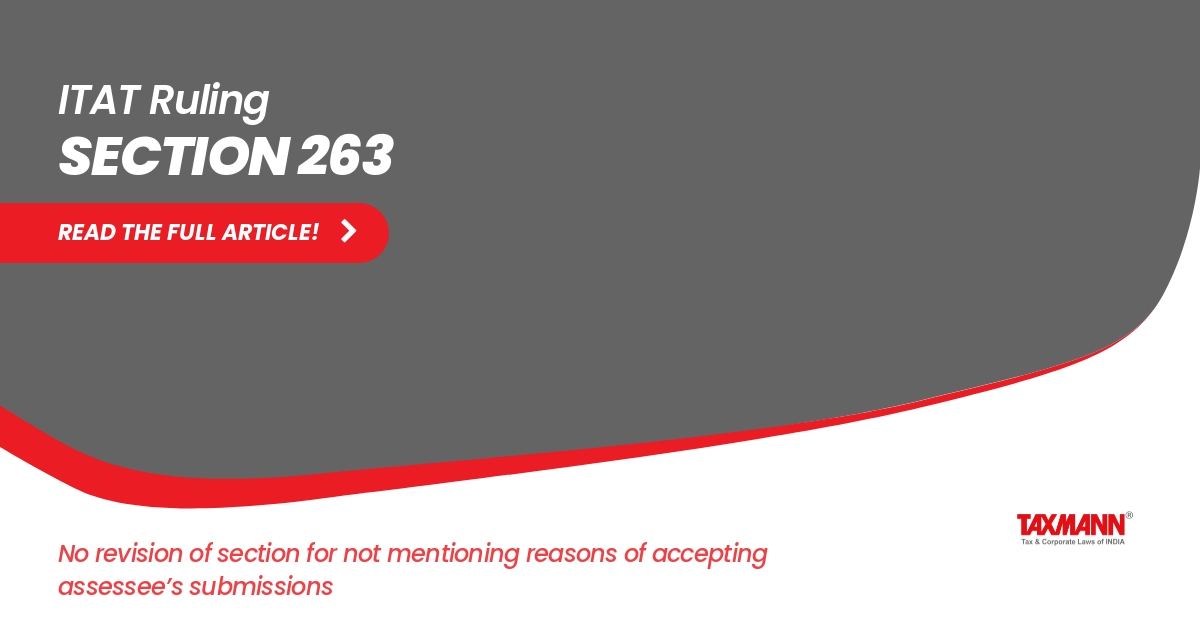No Sec. 263 revision for not mentioning reasons of accepting assessee’s submissions: ITAT
- Blog|News|Income Tax|
- 2 Min Read
- By Taxmann
- |
- Last Updated on 24 March, 2022
Case Details:Reliance Payment Solutions Ltd. v. PCIT - [2022] 136 taxmann.com 277 (Mumbai - Trib.)
Judiciary and Counsel Details
-
- Pramod Kumar, Vice-President and Kuldip Singh, Judicial Member
- Nimesh Vora for the Appellant.
- Sandeep Raj for the Respondent.
Facts of the Case
Assessee was engaged in the business of ‘operation of the semi-closed prepaid instrument by the RBI’. During the assessment, the Assessing Officer raised an issue with regards to a higher claim of depreciation, and the assessee filed a detailed reply stating there was no excess depreciation claimed by it.
However, the Assessing Officer (AO) didn’t make any observations on this in the Assessment Order. In this backdrop, the Principal Commissioner initiated revisional proceedings under section 263.
Assessee filed appeal against initiation of revisional proceedings before the Mumbai Tribunal.
ITAT Held
The Mumbai Tribunal held that the PCIT had initiated revisional proceedings on the short ground that AO passed the assessment order without making any further enquiry. He concluded that in the absence of any specific inquiry made by the AO or recording his reason for accepting the assessee’s submission without any appropriate evidence, it couldn’t be said that the assessee duly submitted documents.
Thus, the question before the tribunal was whether non-recording of the reasons for accepting explanation would render the order erroneous and prejudicial to the interest of the revenue?
The action of AO in accepting an explanation of the assessee cannot be faulted merely because it could have been lawful to make mere detailed inquiries or because he did not write specific reasons for accepting the explanation. As for PCIT’s observations regarding accepting the explanation “without appropriate evidence”, there was nothing to question the bona fides of the AO or to elaborate as to what should have been ‘appropriate’ evidence.
The issue raised in the revision order was specifically looked into, detailed submissions were made and the AO duly accepted these submissions. Thus, merely because AO did not write specific reasons for accepting the assessee’s explanation, it cannot be reason enough to invoke powers under section 263 and non-mentioning of these reasons does not render the assessment order erroneous and prejudicial to the interest of the revenue.
Disclaimer: The content/information published on the website is only for general information of the user and shall not be construed as legal advice. While the Taxmann has exercised reasonable efforts to ensure the veracity of information/content published, Taxmann shall be under no liability in any manner whatsoever for incorrect information, if any.

Taxmann Publications has a dedicated in-house Research & Editorial Team. This team consists of a team of Chartered Accountants, Company Secretaries, and Lawyers. This team works under the guidance and supervision of editor-in-chief Mr Rakesh Bhargava.
The Research and Editorial Team is responsible for developing reliable and accurate content for the readers. The team follows the six-sigma approach to achieve the benchmark of zero error in its publications and research platforms. The team ensures that the following publication guidelines are thoroughly followed while developing the content:
- The statutory material is obtained only from the authorized and reliable sources
- All the latest developments in the judicial and legislative fields are covered
- Prepare the analytical write-ups on current, controversial, and important issues to help the readers to understand the concept and its implications
- Every content published by Taxmann is complete, accurate and lucid
- All evidence-based statements are supported with proper reference to Section, Circular No., Notification No. or citations
- The golden rules of grammar, style and consistency are thoroughly followed
- Font and size that’s easy to read and remain consistent across all imprint and digital publications are applied








 CA | CS | CMA
CA | CS | CMA


